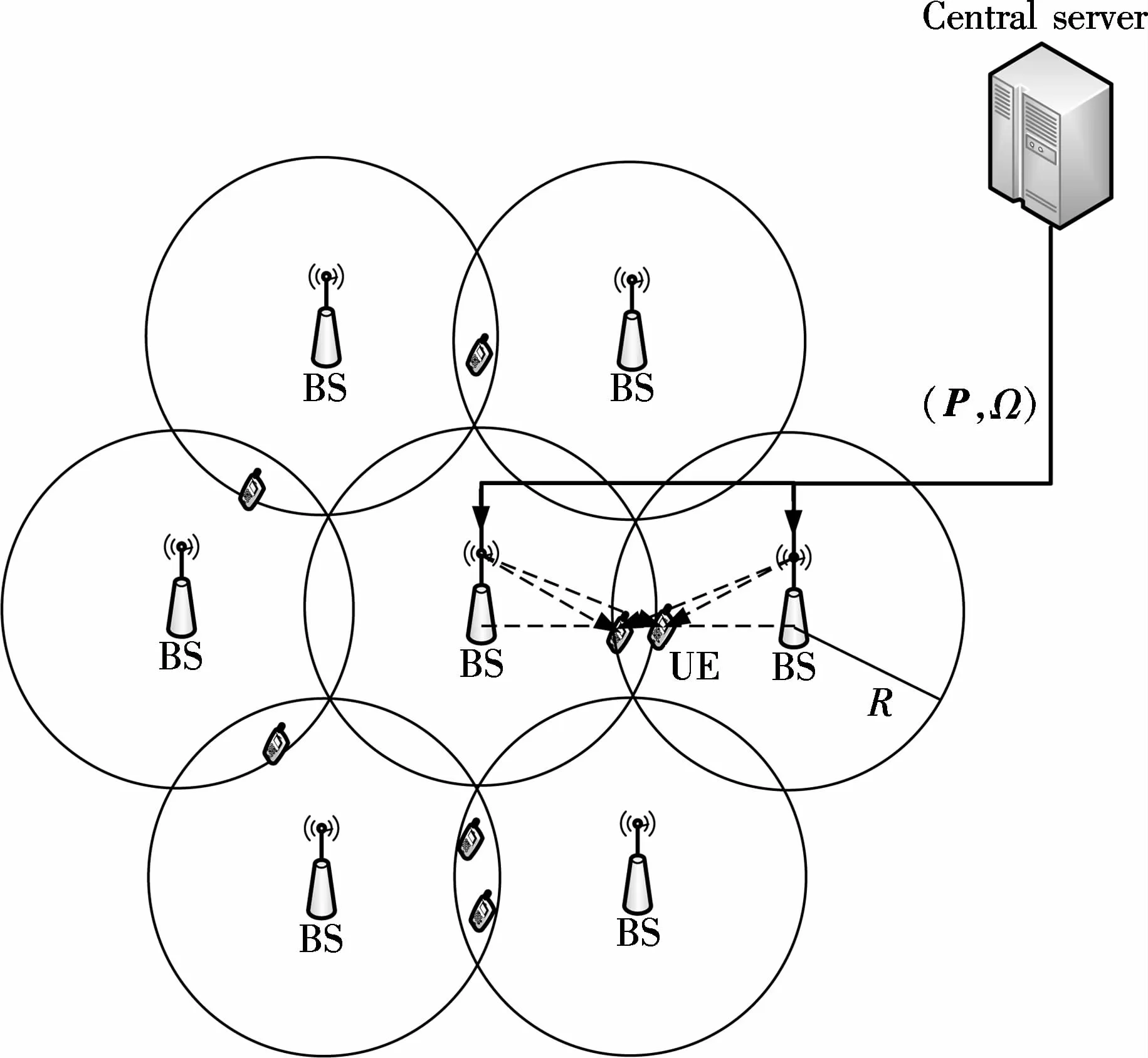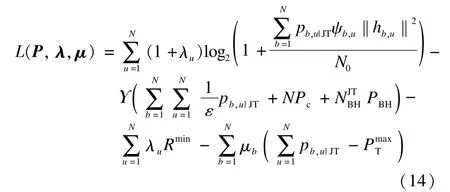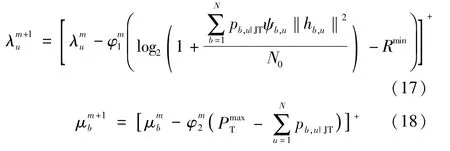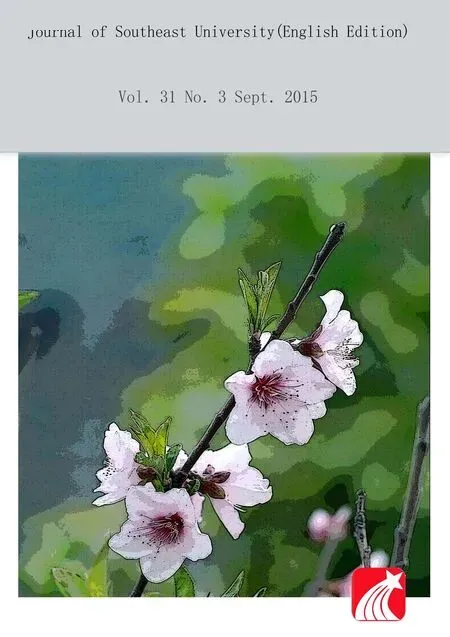CoMP-transm ission-based energy-efficient scheme selection algorithm for LTE-A system s
Tong EnGong ShuleiPan ZhiwenYou Xiaohu
(1National Mobile Communications Research Laboratory,Southeast University,Nanjing 210096,China)
(2School of Electronic Science and Engineering,Nanjing University,Nanjing 210013,China)
CoMP-transm ission-based energy-efficient scheme selection algorithm for LTE-A system s
Tong En1Gong Shulei2Pan Zhiwen1You Xiaohu1
(1National Mobile Communications Research Laboratory,Southeast University,Nanjing 210096,China)
(2School of Electronic Science and Engineering,Nanjing University,Nanjing 210013,China)
In order to achieve higher system energy efficiency(EE),a new coordinated multipoint(CoMP)-transmissionbased scheme selection energy saving(CTSES)algorithm is proposed for downlink homogeneous cellular networks.The problem is formulated as an optimization of maximizing system EE,under the constraints of the data rate requirement and themaximum transmit power.The problem is decomposed into power allocation and alternative scheme selection problems.Optimal power allocation is calculated for CoMP-JT(joint transmission)and CoMP-CS(coordinated scheduling)transmissions,and the scheme w ith higher EE is chosen.Since the optimal problem is a nonlinear fractional optimization problem for both CoMP transmission schemes,the problem is transformed into an equivalent problem using the parametric method.The optimal transmit power and optimal EE are obtained by an iteration algorithm in CoMP-JT and CoMP-CS schemes.Simulation results show that the proposed algorithm offers obvious energy-saving potential and outperforms the fixed CoMP transm ission scheme.Under the condition of the same maximum transmit power limit,the empirical regularity of user distribution for scheme choice is presented,and using this regularity,the computational complexity can be reduced.
energy efficiency;green radio;coordinated multipoint;scheme selection;nonlinear fractional programming
G reen radio enjoyed popular support in past years.From an operator’s perspective,decreasing energy consumption w ill reduce operating expenditure(OPEX)costs.From the pointof environmental protection,an ever increasing expenditure of energy directly leads to the rise of carbon dioxide em issions.Naturally,there is an imperative need to find more effective ways of reducing energy consumption in future w ireless communication systems.
Generally speaking,energy efficient technologies are mainly divided into the follow ing three aspects:energy saving technology in base stations,network deployment strategy and enabling technologies[1].The coordinated multipoint(CoMP)transm ission technique is one of the enabling technologies,which has the potential to promote system.Based on different data sharing and channel state information(CSI)feedbackmechanisms,CoMP transm ission is mainly classified into joint transm ission(JT)and coordinated scheduling(CS)transmission schemes[5].Extensive work has been done in the area of CoMP and there is no doubt that the cell-edge user’s capacity can be effectively improved under CoMP transm is-.However,higher capacity is not necessarily related to higher EE because of the additional power consumption for the signal processing and backhauling[7].EE comparison between CoMP and the conventional non-CoMP system is presented over realistic power consumption models(PCM)in Ref.[8].The overall energy consumption of a network is composed of transm it power,processing power and backhaul power in realistic PCM.The authors defined EE gain and provided the comparison.The results show that in comparison w ith conventional non-cooperative systems,EE gain arises from an increase in spectral efficiency.
One of the recently proposed energy saving schemes in CoMP scenario is the cell sw itch-off scheme.In traditional cell sw itch-off schemes,the traffic in the sw itched-off cell is served by surround cells whose transm it powers may increase.Combining cell switch-off w ith CoMP technology leads to a more energy efficient solution,while the transm it powers of the remaining active cells may not increase[9].
Another type of energy saving schemes in CoMP scenario is the resource allocation.In Ref.[11],the authors put forward an iterative energy-efficient power allocation algorithm in an CoMP-JT system.The original non-convex optim ization problem is transformed into a subtractive equivalent optimization problem.Dual decomposition is used to achieve the power allocation.As wementioned,either a CoMP-JT or CoMP-CS transm ission scheme can be employed.However,the authors did not consider the CoMP-CS scheme.Another previous re-port showed that system EE can bemaxim ized by optim izing the allocation of both transm it time and transm it power under CoMP-JT and CoMP-CS schemes[12].The authors formulated the problem as m inim izing the total transm it power.Yet,the power consumption model only consists of the basic transm it power,while both the circuit power and backhaul power are not taken into account.
It is well accepted that CoMP schemes can promote system EE,while it is not clear which scheme is better in a specific scenario.Compelling evidence in this regard is currently lacking.Therefore,we investigate the energyefficient CoMP transm ission scheme selection algorithm employing a realistic power consumption model.Results show that the proposed algorithm ismore energy-efficient than CoMP-JT only and CoMP-CS onlymodes.We summarize the regularity based on enormous simulation data for a fixed maximum transmit power scenario.
1 System M odel
A downlink CoMP system consisting of N cooperative BSs and N users is considered,as shown in Fig.1.(P,Ω)denote the transmit power of users and the selected CoMP scheme by the central server,respectively.All transceivers are equipped w ith a single antenna.Both the CoMP-JT scheme and the CoMP-CS scheme are considered.Assume that global channel state information is perfectly known by the central server and all calculations and power allocation management are performed in it.In the considered scenario,interference is assumed to be elim inated by the precoding algorithm.

Fig.1 An example of CoMP system
1.1 CoMP-JT
Let xu,u={1,2,…,N},denote the data symbol jointly transm itted by the N cooperative BSs under CoMP-JT transm ission.Assum ing that xuis normalized as1,let pb,u|JTdenote the transmit power for user u from the b-th BS,b={1,2,…,N}.Then,the signal-to-noise ratio(SNR)of user u can be expressed as

whereψb,urepresents the combined path loss and shadow fading[13]between BS b and user u;hb,urepresents the small scale fading channel between BS b and user u,which is an independent and identically distributed complex Gaussian random variable w ith zero mean and unit variance;N0is the variance of complex independent zero mean additivewhite Gaussian noise.The achievable spectral efficiency(SE)of user u in bit/(s·Hz)is determ ined by

1.2 CoMP-CS
The data symbol of a user is only transm itted by its serving BS under CoMP-CS.Let pb,u|CSdenote the transmit power for user u from the b-th BS.The possible BS-user sets are denoted byΨ(i)={φi,1,φi,2,…,φi,N},i={1,2,…,NN},where i andφi,urepresent the set index and the serving BS of user u,respectively.The exhaustive search method is employed to find the appropriate BS-user se={φi^,1,φi^,2,…,φi^,N},which has the best channel state.given by

The SNR of user u can be expressed as

and the achievable SE is

1.3 Energy consumption model
The total power consumption of a coordinated mobile radio network includes the backhaul power,the transm it power and circuit power.Letanddenote the overall power consumption of CoMP-JT and CoMP-CS scheme.They are obtained

The first terms in Eqs.(6a)and(6b)represent the power consumption of the power amplifiers,and 0<ε≤1is a constantwhich stands for the efficiency of the power amplifier.The second terms represent the overall signal processing consumption of N BSs,and Pcis the constant signal processing power.The last terms represent the backhaul consumption;andare the numbers of backhaul links,and each link is assumed to have a fixed power consumption of PBH.
1.4 Definition of energy efficiency
In the literature,several different definitions of energy efficiency have been used[16].We adopt themost popular one,which is defined as the ratio of the system SE to the power consumption,measured in bit/(J·Hz):

2 Problem Formulation
LetΩ*denote the selected CoMP scheme and P*(Ω),b={1,2,…,N},u={1,2,…,N},denote the optimal power allocation policy under the scheme policyΩ∈{′JT′,′CS′}.The optimization problem can be formulated as

3 Solution of the Problem
In this section,a CoMP-transmission-based scheme selection energy saving(CTSES)algorithm is proposed to maxim ize the system energy efficiency,w ith the flow chart in Fig.2.For a specific location in the coverage area,we need to determ ine the optimal power allocation policy and transmission scheme policy.First,the central server evaluates the optimal power allocation and system energy efficiency under CoMP-JT and CoMP-CS schemes.Then,the CoMP schemew ith higher energy efficiency is selected by the central server.The system obtains themaximum energy efficiency by applying the chosen CoMP scheme and power allocation.

Fig.2 Flow chart of the CTSES algorithm
3.1 Iterative algorithm for power allocation
The objective function(8)is the ratio of two functions.The optimization problem is commonly known as nonlinear fractional programm ing.Dinkelbach’s parametric approach is employed to solve the problem.First,problem(8)is converted into the following non-fractional optim ization problem[17]:

whereΥis a constant.According to Ref.[17],finding Υ*that renders

is equivalent to solving problem(8).An iterative algo-rithm for power allocation is put forward to solve the equivalent problem(12),which is summarized below.Υ(t)means the value ofΥat the t-th iteration.Tmaxandφ represent themaximum number of iterations and themaximum tolerance,respectively.The algorithm guarantees the convergence to the optimal energy efficiency as long aswe can solve problem(12)in each iteration[17].Next,the above-mentioned iterative method is adopted to solve problem(12)under CoMP-JT and CoMP-CS transm ission schemes.
Algorithm 1 Iterative algorithm for power allocation
Initialization:SetΥ(1)=0,Tmax=10,φ=10-4.
For t=1∶Tmax
Calculate the power allocation policy P(t)(Ω)for a givenΥ(t)according to Eqs.(13)and(18);

End if;
End for;
If convergence=0;

End if;
Stop the algorithm and the solution is P*(Ω),Ω=(′JT′,′CS′);
3.2 Power allocation for CoMP-JT transm ission scheme
Under CoMP-JT transmission scheme,the Lagrangian function of problem(12)can be w ritten as

whereλ={λ1,λ2,…,λN}≥0 andμ={μ1,μ2,…,μN}≥0 are the introduced Lagrange multipliers.Then,differentiating Eq.(14)w ith respect to pb,u|JTleads to

Power allocation for user u from BS b can be obtained by applying the Karush-Kuhn-Tucker(KKT)[18]conditions.

where[x]+=max{0,x};λuandμbare the multipliers,which can be updated using the sub-gradientmethod[19].

where m≥0 is the iteration index;andare the step sizes.
3.3 Power allocation for CoMP-CS transm ission scheme As for the CoMP-CS transm ission scheme,the Lagrangian function of problem(12)is

whereη={η1,η2,…,ηN}≥0 andθ={θ1,θ2,…,θN}≥0 are the introduced Lagrangemultipliers.After differentiating(19)w ith respect to pφi^,u,u|CS,we obtain

Sim ilarly,applying the KKT conditions,power allocation for mobile users under the CoMP-CS transm ission scheme can be obtained by

Themultipliers are given by

3.4 CoMP scheme selection algorithm
W ith optimal power allocation policy P*(JT)and P*(CS)obtained from the above procedures,EE is given by

The CoMP scheme w ith higher EE is selected as follows:

4 Simulation and Analysis
The performance of the proposed CTSES algorithm is validated through simulations.In order to facilitate illustration and reduce complexity,only two-user two-BS situation is considered.We assume that users are distributed on the straight line between two BSs.Main system parameters are listed in Tab.1.The 3GPP urban path loss model is adopted[20].Let db,urepresent the distance between user u and BS b,in km.The minimum rate requirement of each user is 0.5 bit/(s·Hz).

Tab.1 Simulation parameters
4.1 EE performance com parison of CTSES,CoMPJT and CoMP-CS
Fig.3 shows that the proposed CTSES algorithm outperforms the conventional CoMP-JT transmission and CoMP-CS transm ission.Here,we assume that users are located around BSsw ith the same distance,namely d1,1=d2,2.Maximum transm it power PmaxT=40 dBm,and cell radius R=500 m.When d1,1=500 m,CTSES outperforms CoMP-CS and CoMP-JT by 7.5%and 2.2%,respectively.From Fig.3,we can see that system EE decreases gradually as the distance between BS and users increases.In addition,CoMP-CS transmission ismore efficient than CoMP-JT transm ission when the users are closer to the BS.CoMP-JT achieves higher EE than CoMPCS when users are located around the edge of the cell.

Fig.3 Normalized EE performance comparison between CTSES algorithm,traditional CoMP-JT and CoMP-CS(PmaxT=40 dBm,R=500 m)
4.2 EE of CTSES vs.maximum transm it power
Figs.4(a)and(b)show the normalized EE vs.the maximum transm it power.We can see that the EE increases withat lower transm it power and saturates at high transmit power.Furthermore,when=30 dBm, cell radius R=500m,EE performance achieves9.6%improvement as usersmove from 0.8R to 0.6R.When=30 dBm and users are located at 0.8R,EE performance achieves27%improvement as the cell radius changes from 900 m to 500 m.We can infer that EE increaseswhen the cell range reduces or usersmove to the center.The latter has a larger impact on EE.In Fig.4(b),when=30 dBm,CoMP-CS achieves 34.5%performance improvement as users’location varies from R to 0.5R,while CoMP-JT achieves11.2%improvement.Fig.4(b)indicates that CoMP-CS transm ission scheme ismore susceptible to users’location compared w ith CoMP-JT.

Fig.4 Normalized EE performance vs.maximum transm it power.(a)=30 dBm;(b)=30 dBm,R=700 m
4.3 EE of CTSES vs.users’location
Fig.5 shows the normalized EE vs.the distance between the BS and users for the proposed algorithm w ith the fixed maximum transm it power.Assume that maximum transmit power=46 dBm,the cell radius R va-ries from 500 to 1 000 m,and users are distributed from 0.5R to R.We find thatwhen R increases from 500 m to 1 000m,system EE decreases approximately 36%due to the increasing transmit power and decreasing total capacity.

Fig.5 Normalized EE performance vs.the distance between the BS and users(=46 dBm)
4.4 Schem e selection region
Herein we put forward CoMP transm ission scheme suggestions based on user’s location.For conveniently describing the advice,we define 0<du≤1 as the ratio of the distance between user and nearer BS to the cell radius.Extensive simulation experiments have been done and we summarize some regularities.An example is shown in Figs.6 to 7,show ing the selection region of the CoMP system.The horizontal and vertical axes represent the ratios of two users’distance to cell radii,respectively. Maximum transm it power=46 dBm.The CoMP-CS scheme is recommended for the black region where users are relatively far away from the edge.When users are located in the gray area,the CoMP-JT scheme is selected according to the proposed CTSES algorithm.
From Fig.6,we can give sim ilar suggestions for scheme selection under different cell radii for a fixed maximum transm it power.We can infer that scheme selection mainly depends on the relative locations of the users.The different cell radii affect the absolute value of EE.

Fig.6 Spatial distribution of different CoMP schemes

Fig.7 Spatial distribution of different CoMP schemes.(a)=46 dBm,R=500 m;(b)=46 dBm,R=1 000 m
Figs.7(a)and(b)indicate the suggestions when R=500 m and R=1 000 m,respectively.We divide the area into three parts based on the user distribution.The CoMP-CS scheme is selected in area①,where two users’location satisfies-2d1-2d2≤-0.41.The CoMP-JT scheme is recommended in area③,-2d1-2d2≥-0.384 4.When the users are distributed in area②,-0.41<-2d1-2d2<-0.384 4,we can choose any of the CoMP transm ission schemes at random since simulations demonstrate that CoMP-JT and CoMP-CS achieve nearly the same EE in area②.
5 Conclusion
In this paper,the CoMP transm ission scheme selection energy saving algorithm is proposed.The problem of maxim izing EE is formulated as a non-convex problem considering the transmit power consumption,circuit power consumption and backhaul power consumption.It is transformed into an equivalent problem using the parametric method and power allocation is obtained by an iteration algorithm in both CoMP-JT and CoMP-CS schemes.Then,the scheme w ithmaximum EE is selected.Simulation results show that the proposed algorithm achieves higher EE compared w ith CoMP-JT or CoMP-CS only.We summarize the regularity for a fixed maximum transm it power based on a large number of simulations.It is worthy of further detailed study on the impact of more complicated user distribution.
[1]Hasan Z,Boostanimehr H,Bhargava V K.Green cellular networks:a survey,some research issues and challenges[J].IEEE Communications Surveys&Tutorials,2011,13(4):524- 540.
[2]Ismail M,Zhuang W.Network cooperation for energy saving in green radio communications[J].IEEEWireless Communications,2011,18(5):76- 81.
[3]Han F,Safar Z,Liu R.Energy-efficient base-station cooperative operation w ith guaranteed QoS[J].IEEE Transactions on Communications,2013,61(8):3505-3517.
[4]Niu Z S,Zhou S,Hua Y,et al.Energy-aware network planning for w ireless cellular system w ith inter-cell cooperation[J].IEEE Transactions on Wireless Communications,2012,11(4):1412- 1423.
[5]SawahashiM,Kishiyama Y,Morimoto A,etal.Coordinated multipoint transm ission/reception techniques for LTE-advanced coordinated and distributed M IMO[J].IEEEWireless Communications,2010,17(3):26- 34.
[6]Irmer R,Droste H,Marsch P,et al.Coordinated multipoint:concepts,performance,and field trial results[J].IEEE Communications Magazine,2011,49(2):102-111.
[7]Fehske A J,Marsch P,Fettweis G P.Bit per Joule efficiency of cooperating base stations in cellular networks[C]//IEEEGlobecom Workshops.M iami,USA,2010:1406- 1411.
[8]OniretiO,Heliot F,Im ran M A.On the energy efficiency-spectral efficiency trade-off in the uplink of CoMP system[J].IEEE Transactions on Wireless Communications,2012,11(2):556- 561.
[9]Gencer C,Yanikomeroglu H,Yu F R.Cell sw itch off technique combined w ith coordinated multi-point transm ission for energy efficiency in beyond-LTE cellular networks[C]//IEEE ICC Workshop.Ottawa,Canada,2012:5931- 5935.
[10]Zhao W T,Wang SW.Joint subchannel and power allocation inmultiuser OFDM systemsw ithm inimal rate constraints[J].International Journal of Communication Systems,2014,27(1):1- 12.
[11]Ng D W K,Lo E S,Schober R.Energy-efficient resource allocation inmulti-cell OFDMA systems w ith limited backhaul capacity[J].IEEE Transactions on Wireless Communications,2012,11(10):3618- 3631.
[12]Xu Z K,Yang C Y,Li G Y,et al.Energy-efficient cooperative transmission in heterogeneous networks[C]//IEEE Wireless Communications and Networking Conference.Shanghai,China,2013:4226- 4231.
[13]Goldsmith A.Wireless communications[M].Cambridge,UK:Cambridge University Press,2005:105-107.
[14]Arnold O,Richter F,Fettweis G,et al.Power consumption modeling of different base station types in heterogeneous cellular networks[C]//Future Network Mobile Proceedings.Florence,Italy,2010:1- 8.
[15]Monti P,Tombaz S,Wosinska L,et al.Mobile backhaul in heterogeneous network deployments:technology options and power consumption[C]//Transparent Optical Networks.Hong Kong,China,2012:1- 7.
[16]Chen M T,Kim H,Yang Y.Energy efficiency metrics for green w ireless communications[C]//International Conference on Wireless Communications and Signal Processing.Nanjing,China,2010:1- 6.
[17]Dinkelbach W.On nonlinear fractional programm ing[J].Management Science,1967,13:492- 498.
[18]Boyd S,Vandenberghe L.Convex optimization[M].Cambridge,UK:Cambridge University Press,2004:213 -215.
[19]Palomar D P,Chiang M.A tutorial on decomposition methods for network utilitymaxim ization[J].IEEE Journal on Selected Areas in Communications,2006,24(8):1439- 1451.
[20]3GPP.TR 36.814 V9.0.0.3rd generation partnership project;Technical specification group radio access network;Evolved universal terrestrial radio access(EUTRA);Further advancements for E-UTRA physical layer aspects(Release 9)[S].Valbonne,France:3GPP,2010.
LTE-A系统中基于CoMP传输模式选择的节能算法
童 恩1龚淑蕾2潘志文1尤肖虎1
(1东南大学移动通信国家重点实验室,南京210096)
(2南京大学电子科学与工程学院,南京210013)
为了有效提升系统能量效率,提出下行同构网络中基于多点协作传输模式选择的节能算法.在考虑用户速率需求和系统发射功率限制条件前提下构建以最大化系统能效为目标函数的最优化问题.将目标问题分解成功率优化和模式选择2个子问题:首先计算CoMP-JT和CoMP-CS传输模式下的功率分配矩阵,然后选择能量效率较高的模式作为当前的传输模式.功率优化子问题是非线性分数优化问题,运用参数化方法将其转化为等效凸问题,在CoMP-JT和CoMP-CS下分别通过迭代算法求解最优功率和能效.仿真结果证实了所提方案具有明显的节能潜力,其系统能效优于固定CoMP模式.此外,还总结了相同最大发射功率限制条件下的模式选择规律,运用该规律可大大减少此类场景下的计算复杂度.
能量效率;绿色无线电;多点协作;模式选择;非线性分数规划
TN91
10.3969/j.issn.1003-7985.2015.03.001
2015-01-20.
Biographies:Tong En(1971—),male,doctor;Pan Zhiwen(corresponding author),male,doctor,professor,pzw@seu.edu.cn.
s:The National Science and Technology Major Project(No.2013ZX03001032-004),the National High Technology Research and Development Program of China(863 Program)(No.2014AA01A702),Jiangsu Province Science and Technology Support Program(No.BE2012165),Foundation of Huawei Corp.Ltd.
:Tong En,Gong Shulei,Pan Zhiwen,et al.CoMP-transm ission-based energy-efficient scheme selection algorithm for LTE-A systems[J].Journal of Southeast University(English Edition),2015,31(3):297- 303.
10.3969/j.issn.1003-7985.2015.03.001
 Journal of Southeast University(English Edition)2015年3期
Journal of Southeast University(English Edition)2015年3期
- Journal of Southeast University(English Edition)的其它文章
- Detection optim ization for resonance region radar w ith densemulti-carrier waveform
- Dimensional emotion recognition in whispered speech signal based on cognitive performance evaluation
- Cascaded projection of Gaussian m ixturemodel for emotion recognition in speech and ECG signals
- Action recognition using a hierarchy of feature groups
- Ergodic capacity analysis for device-to-device communication underlaying cellular networks
- Intrusion detection model based on deep belief nets
